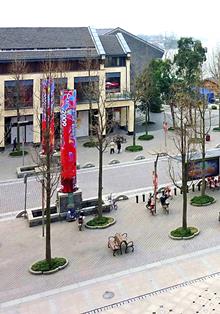

DBD Studio has resulted from cross-pollination of design backgrounds, coming together to create architectural street furniture product design.
...
DBD’s competence embraces the urban landscape with street benches as well as planters and litter bins, bollards and street signs.
...
DBD produce designs for standard and custom made street furniture with a heavy focus on timber products and related technology that are used to to produce optimal quality, environmentally friendly furniture.
DBD happily consider themselves to be at the top of the innovators problem solving game. You see DBD strive to deliver, practical yet cost effective street furniture design that provides excellent amenity which is also extremely attractive to the eye. From initial briefing chats about design intent and consideration of prospective materials, we offer an all embracing design service to match any client’s budget. DBD then develop and project management timetable and oversee third party manufacture and installation from start to finish.
Our central eastern seaboard base enables DBD to offer a really flexible approach to design and customer service. Cutting edge CAD in house design enables us to respond quickly to required design modifications. Moreover, DBD are more than happy to arrange for initial production run samples to the jobsite for final inspection “sign off” to ensure complete satisfaction before mass third party production proceeds. In addition, DBD’s superb supply chain enables it to deliver short lead times.
DBD are proud of its heritage and it many years of street furniture product design experience. DBD provides its clients with unsurpassed street scene advice based on its wide ranging expertise across all building types and urban environments. This combined with our friendly down to earth approach enables us to create the kind of inspirational, long lasting and environmentally friendly street furniture solutions our clients return for time and time again!
Audits are a critical process that has an effect on the performance as well as legal standing of nearly all organizations. Managing an auditing process demands professionalism and trust, assiduousness and also accuracy. The auditing process is utilized in commerce, manufacturing, assessments and quality assurance. Organisations like ours can easily choose to utilise bookkeepers who are either in-house, third party or even a mixture of both. In most cases, the individuals conducting the audit function will probably use a variety of methods within their process like examinations, an auditing app or auditing management software as well as investigations.
The results of an auditing exercise is vital to our enterprise's long term. So, DBD see to it that each audit report is carried out as professionally as possible. Every time an audit is performed, a variety of details need to be evaluated if you want to grant conformity. That's why it is essential to select a suitable supplier of auditing software programs.
The term street furniture has evolved into a collective noun used to describe any upright structure designed to provide pedestrian amenity in streetscape environments. And the vast majority of street furniture is located on the sidewalk. In the last 3 years, an increasing array of different types of street furniture has evolved in line with the pedestrian and traffic behaviour trends in modern towns and cities. An ever increasing “space” demand on our roads has precipitated a concurrent rise in safety, environmental and traffic control regulations Furthermore, the quantities of street furniture on our streets has similarly increased to provide improved seating, shopping booths, newsstands, bus stops and information signs. Urban planners have become more and more conscious of this street furniture proliferation and have and are still acting to overcome and avoid problems associated with location and design of street furniture and its impact on visually or mobility impaired citizens, wheelchair users and everyday pedestrians.
Believe it or not there are many considerations to take into
account regarding design and location of street furniture on our
sidewalks between the kerb and the front of buildings.
There are a number of factors which interrelate with each other in the
streetscape as follows:
- the flow of pedestrian and vehicles
- vehicle flows
- pedestrian flows
- land usage adjacent to sidewalks
- vehicle loading and parking requirements
- the relative width of verges and sidewalk footways
- safety and security
- local street furniture regulations which govern the
location and size of street furniture products
The areas between building frontage and the kerb edge are
generally referred to as follows:
Frontage Area
Sidewalk Area
Planting and Furniture Area Kerb Area
Different
factors are brought to bear in each particular area
depending on its relative location within an urban environment, scale
and prospective amenity provision.
Frontage
Area This
is the area between the property boundary, the sidewalk area and
the outside of the kerb.
Under most normal circumstances, this area is a street
furniture free
zone to allow the visually impaired to use their canes against the
facades of buildings and where shops are present to allow free,
uncluttered window shopping.
In the event that the width of a sidewalk is narrow, street furniture
essential for safety can be located right up against a building in
order to make sure that the kerb area remains
uncluttered. Street
furniture cleaning and maintenance requirements must also be
anticipated and accommodated accordingly.
Sidewalk
Area The
sidewalk
area is normally intended for the flowing, unhindered movement of
normal and mobility enhanced pedestrians. In all but the most
exceptional circumstances, this area should be completely free of
temporary and/or permanent articles. Moreover, within this area any
items of street furniture should be positioned to provide reasonably
clear widths between them.
Planting and
Furniture
Area This is the area where street furniture will
normally be found. If
sufficient space allows, tree plantings or shrub and flower planters
can be located along with street signs and roadway lighting. However,
the designer responsible for such an undertaking must also be cognisant
of the likely growth of plantings and trees and anticipate how that
will affect the appearance of the streetscape over time.
This area may be paved or grassed over but whatever covering is used a
clear delineation between the road and pedestrian walkway must be
provided to increase comfort and safety.
Where high traffic volumes are
present, this is of particular importance.
In areas where the traffic speeds regularly exceeds 30 miles per hour,
the width of this area must be set at the widest possible width so that
greater separation safety between vehicles and pedestrians is provided.
Streetscape designers also take into account both the maximum and
minimum widths of this area in order to allow for the likely volumes of
pedestrians using the walkways and the need for vehicle loading and
unloading etc.
In addition to street furniture, public realm contractors also work in conjunction with traffic light suppliers to make sure that every local ordinance is met and compliance with all pertinent traffic regulations is undertaken.
Kerb
Area Nominally
the kerb area is around eighteen inches wide in order to
allow for the overhang of vehicles. On roads which have a significant
camber or have 40 miles per hour speed limit, the kerb area is normally
increased to 36 inches. This area should be kept clear to prevent
street furniture being damaged by vehicles. On occasion however, street
furniture could be placed in this area if for instance:
- pedestrians need additional “physical” protection
- the street furniture is used for restricting the perceived road width
for traffic calming purposes
- the sidewalk area is restricted.
One other essential factor that
should be borne in mind is the need to properly assess the road camber
to make sure that vehicles with high sides don’t lean over the
sidewalk.
The treatment for each of the foregoing zones in terms of
scale,
relative priority and treatment will naturally vary depending on the
roads position within and urban highway network.
National
Association of Manufacturers
The
National Furniture Association
Wood
Products Manufacturers Association

Dot
Milner
DBD Studios
Washington, DC